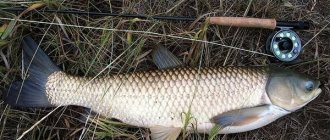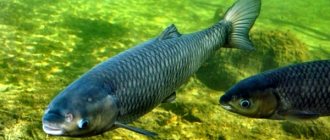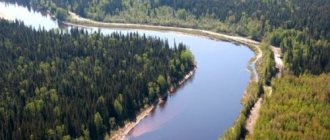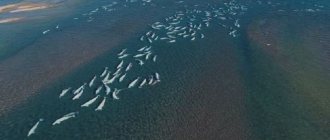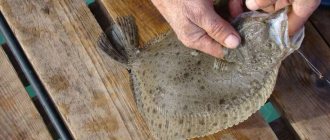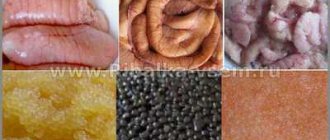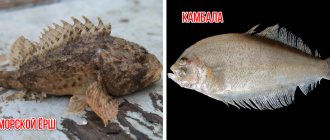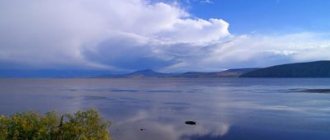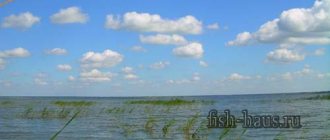Description and general characteristics of fish
White carp is a freshwater inhabitant belonging to the species of ray-finned fish of the Cyprinidae family. The maximum body length of individual individuals is 120–150 cm, but most often fishermen manage to catch smaller representatives - up to 1 m and weighing 45 kg. The annual increase in fish body length is on average 10 cm, although with increased feeding of young fish, it can reach up to 12–15 cm per year (about 6–8 cm per season). The shape of grass carp is cylindrical, the body is slightly laterally compressed and covered with large scales. The head is wide, the mouth is pointed, the lower lip is pushed forward.
Did you know? This representative of cyprinids was first described in 1844 by the French researcher A. Valenciennes, but in a separate genus called
"
Ctenopharyngodon
"
grass carp was identified by Austrian zoologist Franz Steindachner in 1866.
The pharyngeal teeth are double-rowed and located on the last gill arch. The color of the fish is dominated by several colors: the back is greenish or yellow-gray, the sides are silver or golden, and the belly is white or light golden. Each dorsal scale has a dark border, the dorsal and caudal fins are darker, the ventral fins are yellowish and much lighter. The ventral part of grass carp is dark brown, the iris of the eyes is golden.
What does it eat in the pond?
Grass carp can be considered a vegetarian, since the fish eats exclusively plant foods. Young individuals eat zooplankton, and as soon as their intestines lengthen, they switch to algae. However, in artificial growing conditions they do not disdain food intended for carp, and among plants they prefer filamentous grass, soft grass, chara algae, hornwort, duckweed, and reed leaves. The fish do not like the hard stems of the yellow iris, but cut reed leaves, which are easy to get in the water, may well become lunch for the fish described. In cases where there is not enough plant food in the pond, grass mown on the shore is a good choice for feeding grass carp.
Unlike adults, fry are not so harmless and willingly eat insects and small crustaceans that get into the reservoir. Taking this into account, when raising young animals in an aquarium, you can throw ready-made animal food intended for fry of predatory fish into the water.
Fishing technique and tactics
Belamur feeds non-stop from early morning until late evening. But it’s better to catch it in the first half of the day, when the fish are as hungry as possible. To avoid spooking the prey with unnecessary noise and movements, a long cast is required. If the school is close to the shore, the angler takes a position to the side and casts the bait diagonally. But fishing from the opposite shore is especially popular.
To learn more:
Podust: fish lifestyle and fishing methods
You should not throw in bait at the very beginning of fishing, which, falling into the water, can scare away the peacefully feeding fish. You should create a bait cloud of turbidity only when there has not been a single bite for an hour or an hour and a half. Sometimes it is advisable to attach several promising places at once, and start fishing in a calmly unfed area.
When to hook and how to fish out
The hooking time depends on the type of nozzle. If there is a bunch of greenery or a piece of cabbage leaf on the hook, you need to wait for the tip of the feeder or float to constantly tremble and make a sharp and strong swing of the rod. With compact baits (boilie, crawler, corn), grass carp does not stand on ceremony, immediately grabs it and tries to stroke it. In such a situation, an immediate hook is required as soon as the bite alarm goes off.
Fishing for grass carp requires maximum concentration. He will definitely show strong resistance and try to hide in aquatic vegetation. Quite often, the fish meekly follows to the shore, creating a misleading impression of its size. But at some point it makes a powerful jerk, and if the clutch on the reel is not loosened, a breakdown follows.
Breeding methods
Modern breeders know several effective ways to breed grass carp, choosing a specific option based on personal considerations and their capabilities. Stocking water bodies with new individuals is deservedly considered the simplest. But if possible, it’s worth trying to raise fry from eggs.
Did you know? Mass stocking of water bodies of the USSR with grass carp began in the 1960s. First of all, the most suitable places for fish to live in those days included lakes, the water in which was warmed up during industrial use, thereby causing rapid growth of various plants.
Stocking
This option for breeding grass carp is widely practiced in China and partly in India, involving the transfer of selected “fish material” from special nurseries or open reservoirs to an artificially created pond. To achieve success, it is important to buy only high-quality fry or adults transported to their further habitat in accordance with all transportation rules.

The water temperature in temporary tanks should at least approximately correspond to the values current for the reservoirs where you are going to release the fish.
In addition, there are a number of other requirements for the process of transportation and subsequent relocation of acquired fry to a permanent place for their growth and development:
- water for temporary keeping of fish cannot be collected from taps, wells or springs, replacing it with liquid from a river, ponds or lakes, preferably as similar as possible to those where grass carp was previously raised;
- the optimal time for transporting containers with fish is the end of spring or the end of summer, when the days are no longer so hot and the water will not heat up quickly (for the same purpose, it is recommended to transport fry in the morning or evening);
- to cool the water to temperatures comfortable for cupid, it is worth covering the tank with ice packs previously placed in burlap (if you have to transport fish during the daytime);
- Before moving the purchased fish into a closed reservoir, gradually mix water from it into the reservoir for several days so that all its inhabitants become accustomed to the chemical composition and other features of the new liquid;
- If there is a large difference in temperature values, the fish should not be released immediately into stock; it may die from temperature shock.
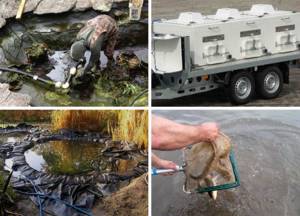
Stocking is the optimal solution for replenishing the underwater fauna when you do not have time to raise fry yourself. Otherwise, it is quite possible to save money and try to get new individuals of grass carp in the process of growing purchased caviar.
Growing from caviar
In its natural habitat, grass carp is often found in the Don, Kuban, Ural and Volga rivers, but in an artificially created reservoir, problems often arise with the process of its natural reproduction. With regular fishing from the stock, the fisherman will have to independently replenish the number of fish, sometimes raising fry from eggs. This breeding process is much more complicated than the previous one, and in addition to the diligence of the owner, it will also require the presence of special equipment (for example, a Weiss apparatus). Under favorable conditions for growing eggs, only 60–70% produce fry, some of which also leave.
Learn how to make hot pink salmon sandwiches.
The spawning process for all representatives of cyprinids takes place every year, at approximately the same time, at a water temperature within the range of +17...+18°C. As soon as the time comes, sexually mature females lay eggs, then the males fertilize some of them with milk, and the rest die, just like the unfertilized ones. Laying occurs in several stages, but during each of them the eggs stick to the vegetation and gradually develop on it. To prevent adults from eating their offspring, they should be temporarily removed from the tank.
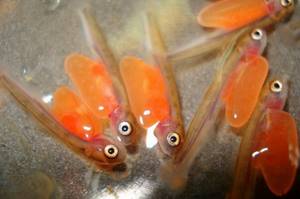
Preparation
Excellent fatty meat is perfect for any fish dishes. It is fried, boiled, smoked, salted. Like all white fish, grass carp has many bones, which cause inconvenience when eating. But since they mainly catch large ones, the bones in it are large, which are easily removed.
Consumers who have had tasty and healthy fish, such as carp, in their diet have appreciated the advantages of this type of carp. Cooking fish begins with cutting it. Which goes the same way as usual. Regardless of what dish will be prepared, with the exception of smoking and drying. The carcass must be cleaned of scales, since the fish has thick meat and must be cut into portions.
Liver and caviar are highly valued and are prepared both with meat and as a separate dish.
Grass carp beneficial properties
The beneficial properties of the river cow have been known for a long time, including the ability to clear water bodies of vegetation, thereby increasing the area for more fish.
On the gastronomic side, fish meat contains many beneficial microelements for humans, magnesium, sodium, calcium, and phosphorus. Vitamins of group B, as well as A, C, E. Calories kcal calorie content is 135 kcal per 100 g. meat. Eating fish dishes is recommended for patients with cardiovascular diseases, poor metabolism and diseased skin.
The process of growing in a home pond
To productively raise young grass carp in an artificially created pond, breeders use various methods to increase breeding productivity, in particular, by using pituitary injections, further artificial insemination and incubation, not to mention the subsequent care of the emerging fry. Each of these stages has its own characteristics.
Important! Grass carp caviar is very sensitive to any mechanical influences, so in order not to crush it, all actions must be performed extremely carefully, having first placed a wide plastic bowl to collect future fry.
Pituitary injections
Injections from extracts obtained from the pituitary glands of carp and crucian carp best contribute to the stimulation of artificial spawning of grass carp. For one kilogram of live weight of fish, 2 mg of the substance is consumed for males, and 4 mg for females, divided into 2 injections: the first time they give only 10% of the prepared dose, and the second - the remaining 90% of the substance. After about a day, the eggs and sperm of the fish are filtered out. To perform these actions, 2 people are required: one holds the fish by the head and tail, and the second runs his hand in the direction from head to tail, as if squeezing the eggs out of an adult fish.
Video: pituitary injection and incubation of carp

Insemination and Incubation
Insemination of the resulting eggs should be carried out as carefully as their removal. The essence of the process is to mix the eggs with 4–6 ml of male carp sperm, after which water from the pond is poured into the resulting mixture, but always in 2 stages: first, no more than 150 ml per 1 liter of eggs, and after a minute another 100 ml. After 5 minutes, the water is drained and the caviar is washed until it begins to swell.
Also learn how to cook sagudai from pink salmon.
As soon as this happens, it is rinsed for the last time, achieving loss of stickiness, and after 1–1.5 hours (by this time the eggs usually reach the size of a black peppercorn) the material is sent to the Weiss apparatus. While in the device, the swelling of the caviar continues for another 4 hours, the main thing is that the water flows in it at a speed of at least 0.5 liters per minute.

Hatching of the larva
As soon as the larvae appear from the eggs placed in the Weiss apparatus, they are moved to a cage made of plastic fine mesh and sent to an artificial reservoir with a low water flow rate. The very next day after birth, almost all of them stay near the bottom, but due to lack of oxygen, many die. Dead larvae and egg shells remaining in the water must be immediately removed from the tray.
We recommend reading about recipes for fried pink salmon caviar.
After another day, the surviving representatives of grass carp are already confidently staying in the water column. The larvae spend 3–6 days in the container until they learn to hold well in a horizontal direction and feed fully. The grown fish along with the tray are moved into an artificial pond, and the plastic mesh is cleaned at least twice a day, ensuring unhindered free circulation of water.
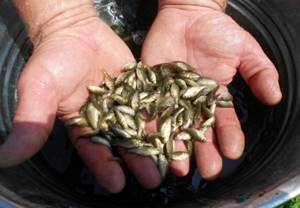
Top dressing
The natural food of the larvae for the first time after hatching is zooplankton, but if there is not enough such material at the place of their breeding, you will have to worry about a good replacement. The most nutritious mixture in this case is deservedly considered to be the version made from grated cottage cheese, boiled egg yolks and dried cyclops. Just 1 ml of such subcortex is enough for 100,000 larvae.
As a last resort, you can use finely ground ready-made granular food produced specifically for fry. As the fish grow, you can gradually switch to coarser feed mixtures. You can protect the larvae’s food from being washed away by the current and ensure easy control over its quantity by using feeders.
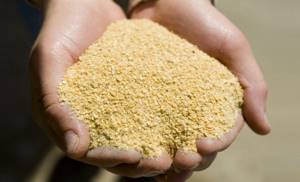
The first feeding after transplanting the young animals into the pond is carried out when the larvae are no more than 4-5 days old, and this is also true if there is a sufficient amount of the above-mentioned plankton. Instead of a curd-egg mixture, soybean meal mixed with water will also work at this time, the main thing is that the size of the grains is small and they float freely on the surface of the water for 35–40 minutes.
On average, they are filled once a day, selecting a specific diet based on the appetite of aquatic inhabitants. A sign of a properly selected menu is considered to be complete consumption of food within 8–10 hours after the next morning feeding. It will not be possible to see exactly how they will consume it, which is explained by the very small size of the larvae.
Important! The pond prepared for the larvae should be filled with water only immediately before they are launched, so that predatory insects do not have time to settle there. At the same time, try to calculate the time so that small plankton has already formed in the reservoir.
Conditions of detention
To grow and even reproduce in stagnant water, grass carp requires conditions close to its natural habitat. During the period of growing larvae, they are kept in fry ponds with an area of 100–200 m², which makes it easy to change the water and control the number of its inhabitants. If the fry are fed regularly, then after 20–30 days their body length will be 2-3 cm, which means you can move the young animals to nursery ponds ranging in size from 500 m² to 5 hectares, filled with liquid shortly before the young animals are moved.
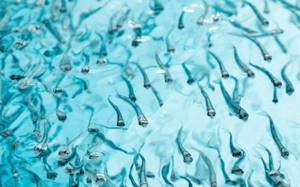
It is best if these are round pools, for each square meter of which there should be 200–300 larvae or 40–50 larger fry. The water temperature in fish habitats should not exceed +20°C.
How does grass carp spend the winter in a pond?
In open natural reservoirs, grass carp can successfully winter even with significant temperature drops, hibernating in the depressions and unevenness of the bottom. A temperature of +1...+2°C is the most optimal for artificial wintering ponds, in which fish also hibernate. During a long winter (until June), grass carp will live well only with regular feeding, and during this period, no more than 10,000–20,000 fingerlings of fish can be kept in each plot of 1,000 m².

With a responsible approach to the issue of growing grass carp, it is successfully bred even in small private farms, thanks to which regular consumption is possible not only by owners of artificial ponds, but also by visiting fishermen, ensuring high profitability from the fishing business. Of course, breeding such fish cannot be called a problem-free task, but knowing about the peculiarities of its nutrition and the most suitable conditions for keeping it, difficulties and troubles can be minimized.
Tips for catching carp
Before you start fishing, it is recommended to provide 3-4 days of bait. Corn is perfect as bait. Half of the bait is thrown into one specific place, the rest is evenly scattered within a radius of 5 m around it. This creates a high concentration of bait, which attracts cupid. In addition to corn, cupid bites well on pea leaves, clover, thin algae and aloe, cleared of thorns, and other plants. Most importantly, the leaves and stems used for bait must be young and tender. You can add flavored oils or earthworm here. Secure the bait on the hook with a strong green thread.
Grass carp are caught using a fishing line 0.7 mm thick, hook No. 7-9, leash 0.6 mm. Rolling tackle and a spinning rod are also suitable for fishing.
Grass carp bites very sharply, immediately swallowing the bait. You need to be prepared for this in order to react as quickly as possible and make a long hook in a timely manner. When a fish gets hooked, you need to bring it to the shore as quickly as possible, without giving it the opportunity to escape, because grass carp, as you know, is very strong, hardy and resourceful. If a fisherman loses his catch, it will no longer be possible to catch it.
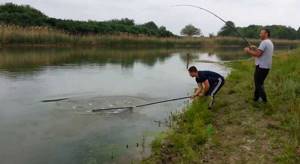
Cupid is a fairly large fish, so when fishing, it is better to be on the safe side with a landing net.
Fishing for carp can be done from bridges and other surface structures and hills. After the bite, a quick upward hook is made, after which the fish is brought to the surface of the reservoir. They take it out using a landing net.
Grass carp is one of the most desirable fish for every avid carp angler. In order to get a good catch, they also catch it at night. Many fishermen note that night fishing is sometimes more successful than daytime fishing, and this is not at all surprising. At night, the reservoir is very quiet and calm; the fish at this moment are less timid and wary than usual. She confidently approaches the bait and willingly swallows it.
This behavior of the cupid is due to the fact that it seems to get used to the behavior of fishermen who leave the pond at dawn, throwing the remaining bait into the water. This bait is perceived by the fish as safe. That is why cupid believes that food lying at the bottom of a reservoir after sunset is not dangerous. Thus, the fish loses vigilance at night.
Video about catching trophy grass carp:
